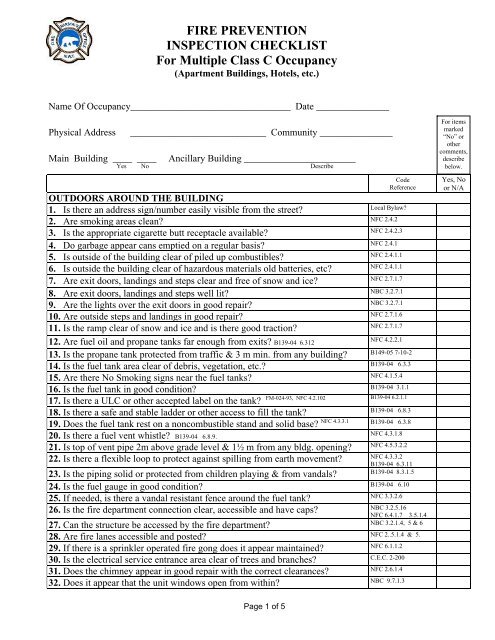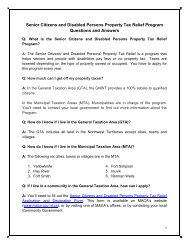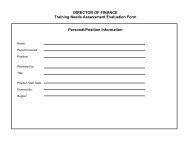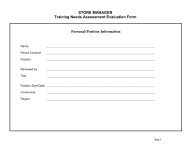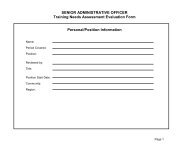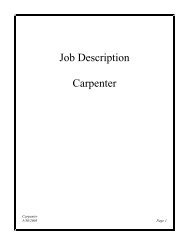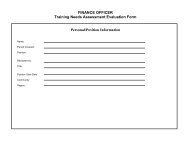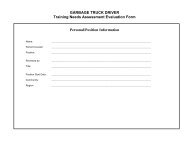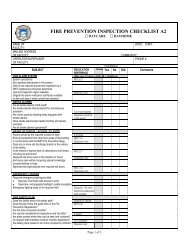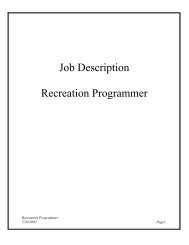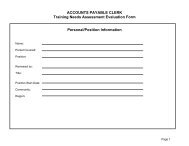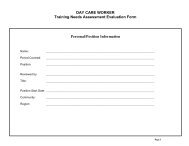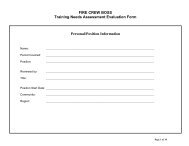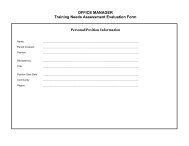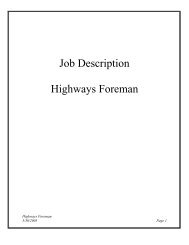FIRE PREVENTION INSPECTION CHECKLIST For Multiple Class C ...
FIRE PREVENTION INSPECTION CHECKLIST For Multiple Class C ...
FIRE PREVENTION INSPECTION CHECKLIST For Multiple Class C ...
Create successful ePaper yourself
Turn your PDF publications into a flip-book with our unique Google optimized e-Paper software.
<strong>FIRE</strong> <strong>PREVENTION</strong><br />
<strong>INSPECTION</strong> <strong>CHECKLIST</strong><br />
<strong>For</strong> <strong>Multiple</strong> <strong>Class</strong> C Occupancy<br />
(Apartment Buildings, Hotels, etc.)<br />
Name Of Occupancy_________________________________ Date _______________<br />
Physical Address<br />
Main Building ____ ____<br />
____________________________ Community _______________<br />
Ancillary Building _______________________<br />
Yes No Describe<br />
Code<br />
Reference<br />
OUTDOORS AROUND THE BUILDING<br />
1. Is there an address sign/number easily visible from the street?<br />
Local Bylaw?<br />
2. Are smoking areas clean?<br />
NFC 2.4.2<br />
3. Is the appropriate cigarette butt receptacle available?<br />
NFC 2.4.2.3<br />
4. Do garbage appear cans emptied on a regular basis?<br />
NFC 2.4.1<br />
5. Is outside of the building clear of piled up combustibles?<br />
NFC 2.4.1.1<br />
6. Is outside the building clear of hazardous materials old batteries, etc?<br />
NFC 2.4.1.1<br />
7. Are exit doors, landings and steps clear and free of snow and ice?<br />
NFC 2.7.1.7<br />
8. Are exit doors, landings and steps well lit?<br />
NBC 3.2.7.1<br />
9. Are the lights over the exit doors in good repair?<br />
NBC 3.2.7.1<br />
10. Are outside steps and landings in good repair?<br />
NFC 2.7.1.6<br />
11. Is the ramp clear of snow and ice and is there good traction?<br />
NFC 2.7.1.7<br />
12. Are fuel oil and propane tanks far enough from exits? B139-04 6.312<br />
NFC 4.2.2.1<br />
13. Is the propane tank protected from traffic & 3 m min. from any building?<br />
B149-05 7-10-2<br />
14. Is the fuel tank area clear of debris, vegetation, etc.?<br />
B139-04 6.3.3<br />
15. Are there No Smoking signs near the fuel tanks?<br />
NFC 4.1.5.4<br />
16. Is the fuel tank in good condition?<br />
B139-04 3.1.1<br />
FM-024-93, NFC 4.2.102<br />
17. Is there a ULC or other accepted label on the tank?<br />
B139-04 6.2.1.1<br />
18. Is there a safe and stable ladder or other access to fill the tank?<br />
B139-04 6.8.3<br />
19. Does the fuel tank rest on a noncombustible stand and solid base? NFC 4.3.3.1 B139-04 6.3.8<br />
20. Is there a fuel vent whistle? B139-04 6.8.9.<br />
NFC 4.3.1.8<br />
21. Is top of vent pipe 2m above grade level & 1½ m from any bldg. opening?<br />
NFC 4.5.3.2.2<br />
22. Is there a flexible loop to protect against spilling from earth movement?<br />
NFC 4.3.3.2<br />
B139-04 6.3.11<br />
23. Is the piping solid or protected from children playing & from vandals?<br />
B139-04 8.3.1.5<br />
24. Is the fuel gauge in good condition?<br />
B139-04 6.10<br />
25. If needed, is there a vandal resistant fence around the fuel tank?<br />
NFC 3.3.2.6<br />
26. Is the fire department connection clear, accessible and have caps?<br />
NBC 3.2.5.16<br />
NFC 6.4.1.7 3.5.1.4<br />
27. Can the structure be accessed by the fire department?<br />
NBC 3.2.1.4, 5 & 6<br />
28. Are fire lanes accessible and posted?<br />
NFC 2..5.1.4 & 5.<br />
29. If there is a sprinkler operated fire gong does it appear maintained?<br />
NFC 6.1.1.2<br />
30. Is the electrical service entrance area clear of trees and branches?<br />
C.E.C. 2-200<br />
31. Does the chimney appear in good repair with the correct clearances?<br />
NFC 2.6.1.4<br />
32. Does it appear that the unit windows open from within?<br />
NBC 9.7.1.3<br />
<strong>For</strong> items<br />
marked<br />
“No” or<br />
other<br />
comments,<br />
describe<br />
below.<br />
Yes, No<br />
or N/A<br />
Page 1 of 5
Code<br />
Reference<br />
33. Are balconies clear of excess storage and hazardous goods?<br />
NFC 2.4.1.1<br />
34. Does the use of barbeques on balconies conform to local regulations?<br />
Local Bylaw?<br />
35. Is the roof area over the exits free of falling ice & snow hazards?<br />
NFC 2.7.1.7<br />
36. Is the area around the commercial range hood clean & free of grease?<br />
NFC 2.6.1.9<br />
37. Are all electrical wires out of reach of the public?<br />
CEC 2-200<br />
38. Are overhead wires out of reach of a fire dept. ladder being raised?<br />
CEC-2-202<br />
Yes, No<br />
or N/A<br />
INDOORS HOUSEKEEPING and GENERAL <strong>FIRE</strong> SAFETY<br />
39. Do the interior surfaces of the exit appear to have a FSR less than 25?<br />
NBC 9.10.16.3<br />
40. Is there a(n) fire alarm / enunciator panel visible as you enter the building.<br />
NBC 3.2.4.8.4<br />
41. Is that panel in good condition and only the correct light emitting diodes lit?<br />
NBC 3.2.4.5.2<br />
42. Are records of recent Fire Alarm System maintenance available?<br />
NBC 3.2.4.5.2<br />
43. Are fire extinguishers visible, accessible, pin & seal in place, pressure OK<br />
Page 2 of 5<br />
NFC 6.1.1.2<br />
NFC 6.2.4.5<br />
tag current year’s, and tag initialed monthly?<br />
44. Are all areas free of clutter and excessive combustible material?<br />
NFC 2.4.1.1.1<br />
45. Is there adequate clearance (45 cm or 18 in.) from sprinkler heads?<br />
NFPA 13 - 8.5.6.1<br />
46. Are all sprinkler heads free from paint, lint, dirt or hanging items.<br />
NFPA 13 – 6.2.6.4.4<br />
47. Are all sprinkler pipes free from things hanging from them?<br />
NFPA 13 – 1.6.1.7<br />
48. Are sprinkler heads quick response (very thin tube of liquid)?<br />
NWT FM-004-88<br />
49. Are the sprinkler heads rated for the hazard in the area? e.g. higher in kitchens<br />
NFPA 13 – 6.2.5.1<br />
50. Are smoking areas clean, with the appropriate butt receptacle?<br />
NFC 2.4.2.1<br />
51. Do garbage appear cans emptied on a regular basis?<br />
NFC 2.4.1.1<br />
52. If there is a interior garbage area does it appear under control?<br />
NFC 2.4.1.1<br />
53. In the interior garbage area do printed signs say to keep trash under control?<br />
NFC 2.4.1.1<br />
54. Are crawl spaces, attics, under the stairs spaces, etc. free from storage?<br />
NFC 2.4.1.1<br />
55. Is an evacuation plan posted? (Required by if there is a fire alarms system.)<br />
NFC 2.8.2.1<br />
56. Is there a sign that says to alert the fire dept. because the fire alarm doesn’t?<br />
NBC 3.2.4.7.6<br />
57. If there is such a sign, does it include the fire department phone number?<br />
NBC 3.2.4.7.6<br />
58. If there is an elevator is there firefighter key access in the elevator?<br />
NFC 7.1.1.4<br />
NBC 3.2.6.5<br />
59. Does the elevator appear in good repair with a current inspector’s certificate?<br />
NFC 7.2.2.1.1<br />
60. Is all foamed plastic insulation properly protected from fire?<br />
NBC 3.1.5.11<br />
NBC 9.10.16.10<br />
61. Do the individual units have smoke alarms?<br />
NBC 3.2.4.21<br />
62. Do public areas have properly located & rated fire extinguishers?<br />
NFC 6.2.3.3<br />
63. Does each corridor have a second means of exit? Max. dead end length is 6 m.<br />
NBC 3.3.1.9<br />
MEANS OF EGRESS<br />
64. Are EXIT signs readily visible and lit?<br />
NFC 2.7.3.1<br />
65. Do the EXIT signs actually lead to an approved exit?<br />
NBC 3.4.5.1<br />
66. Is there an extinguisher mounted near each exit door?<br />
NFC 6.2.1.3<br />
67. Is there adequate lighting in the corridors?<br />
NBC 3.2.7.1<br />
68. Does emergency lighting show a path to the exit?<br />
NBC 3.2.7.3<br />
69. Can the emergency lighting units be reached for testing?<br />
NBC 3.2.7.3<br />
70. Does the emergency lighting light up when tested?<br />
NFC 2.7.3.1<br />
71. Do the EXIT signs light up when the emergency lighting is tested?<br />
NFC 2.7.3.1<br />
72. Are all fire alarm pull stations visible and accessible?<br />
NBC 3.2.4.17
Code<br />
Reference<br />
73. Is there a pull station near each exit?<br />
NBC 3.2.4.17<br />
74. Are there glass bars in all of the pull stations?<br />
NFC .6.1.1.2<br />
75. Does there appear to be sufficient exit width for the occupancy load?<br />
NBC 9.9.3.3<br />
76. Are the Occupancy Load certificates posted?<br />
NFC 2.7.1.4<br />
77. Is there panic hardware? (Required if occupancy load is more than 50 people.)<br />
NWT F P Act 18.1<br />
78. Where there are double doors, do both doors open?<br />
NFC 2.2.2.4<br />
79. Are exit doors clear, easy to open, self-closing and well lit?<br />
NFC 2.2.2.4<br />
80. Are there signs of chains being used on the exit doors?<br />
NFC 2.7.1.6<br />
81. Is all door release (panic) hardware in good condition?<br />
NFC 2.2.2.4<br />
82. If occupant load is more than 60, do doors swing in direction of exit travel?<br />
NBC 3.3.1.10<br />
83. Is there adequate corridor clearance of at least 1100 mm?<br />
NBC 9.9.3.3<br />
84. Are the corridors kept clear of all storage including bicycles?<br />
NFC 2.7.1.6<br />
85. Are all stairwells free of storage?<br />
NFC 2.4.1.1.3<br />
86. Is there emergency lighting in all the stairwells?<br />
NBC 3.2.7.3<br />
87. Are there continuous handrails in the stairwells?<br />
NBC 3.4.6.4<br />
88. Are the handrails in good condition?<br />
NFC 2.7.1.6<br />
89. Are there approved closers where required?<br />
NFC 2.2.2.4<br />
90. Are all stairwell doors kept closed?<br />
NFC 2.2.2.4.2<br />
91. Have all the door wedges and door-hold-open feet been removed?<br />
NFC 2.2.2.4<br />
92. Do the stairwell door closers and latching hardware function?<br />
NFC 2.2.2.4<br />
93. Are the smoke seals in place and in good condition?<br />
NFC 2.2.2.4<br />
94. Are corridors clear of combustible or other hazardous materials?<br />
NFC 2.4.1.1.2<br />
95. Do all the apartment doors have approved doors, latching and closers?<br />
NBC 3.1.8.11 & 13<br />
NBC, 3.1.8.4<br />
96. Do the corridor walls and ceiling appear to have a FSR of less than 75?<br />
NBC 3.1.13.6<br />
Yes, No<br />
or N/A<br />
KITCHEN or COOKING AREA<br />
97. Does the commercial range appear in good repair and is it clean?<br />
NFC 2.6.1.9.6<br />
98. Does the deep fat fryer appear in good repair and is it clean?<br />
NFC 2.6.1.9.6<br />
99. Is the commercial range hood clean?<br />
NFC 2.6.1.9.3<br />
100. Is there a wet chemical fire extinguishing systems in the range hood?<br />
NFPA 17A<br />
101. Does a tag show suppression system service within the last year?<br />
NFPA 17A 7.3.2.6<br />
102. Are the fusible links in the range hood recent and or new?<br />
NFPA 17A 7.3.3<br />
103. Is there an emergency shut off for the fuel to the range easily available?<br />
NFPA 96 10.4.1<br />
104. Do sprinkler heads appear to be rated for a higher temperature?<br />
NFPA 13 8.3.2.5.7<br />
105. Is there a type “K” fire extinguisher within 9.25m of the deep fat fryer?<br />
NFPA 10 6.6.1<br />
FURNACE, BOILER, SPRINKLER, UTILITY& ELECTRICAL ROOMS<br />
106. Is the door kept locked against unauthorized entry?<br />
NFC 2.6.3.2<br />
107. Does the door appear to be 45 min fire rated?<br />
NBC 3.6.2. & 3.1.8.4<br />
NWT FM 056-98<br />
108. Does the door have an approved closer?<br />
NBC 3.1.8.11<br />
109. Does the door have an approved metal frame?<br />
NBC 1.1.3.2 Closure<br />
110. Does the door self close and latch?<br />
NBC 3.1.8.13<br />
111. Do the walls and ceiling appear to one hour fire rated?<br />
NBC 3.6.2.1.<br />
Page 3 of 5
Code<br />
Reference<br />
NBC 3.6.2.<br />
NWT FM 056-98<br />
112. Are the ceiling and walls without holes or unsealed perforations?<br />
113. Is the room clear of combustible and other inappropriate storage?<br />
NBC 3.6.1.3<br />
114. Does the housekeeping reflect a proactive attitude towards fire safety?<br />
NBC 3.2.7.3<br />
115. Is there an extinguisher very near the door?<br />
NFPA 10 E.2<br />
116. Is the room well lit?<br />
NBC 9.34.2.7<br />
117. Is there is emergency lighting does it function when tested?<br />
NFC 6.7.1.6<br />
118. Does the fuel tank have a ULC or API label<br />
NFC 4.2.12.1<br />
119. Do all dead end fuel lines have a threaded plug or cap installed?<br />
B-139-04 3.3.1,<br />
3.3.2 & 3.4.1<br />
120. Is the floor free of fuel spills?<br />
NFC 4.1.6.3<br />
121. Is there a fusible valve in the fuel oil line within 1m of each appliance?<br />
NWT FM 23-93<br />
122. Is there a fusible valve in the fuel line on supply side of each fuel filter?<br />
NWT FM 28-93<br />
123. Is there a metal drip pan below each fuel filter?<br />
NFPA 4.1.6.3<br />
124. Is there adequate room to service the fuel burning appliances?<br />
B139-04 7.2<br />
B139-04 3.6<br />
125. Do the clearances from the appliances to combustibles look reasonable?<br />
B139-04 7.1.1<br />
126. Does the chimney(s)appear stable, clean and in good repair?<br />
NFC 2.6.1.4<br />
127. Have the fuel burning appliances been maintained in the last year?<br />
B139-04 14.2.1<br />
128. Are fusible linked dampers in the ducts where they penetrate the wall?<br />
NBC 3.1.8.7<br />
129. Is room free from signs of improper fuel or electrical installations?<br />
NFC 2.4.7.1<br />
B139-04 3.9.1<br />
NWT F Prev. Act 12 (3)<br />
NFC 2.4.7.1<br />
NWT F Prev. Act 12 (3)<br />
NFC 2.4.7.1<br />
NFPA 72 5.5.2<br />
130. Is the room free from signs of previous fires or of overheated appliances?<br />
131. Does the room smell free of smoke or overheating electrical equipment?<br />
132. If there is a fire alarm system and no sprinkler system,<br />
is there a heat detector on the ceiling?<br />
133. Do ventilation fans shut down when fire alarm activates?(more than 2 stories) NFC 7.2.4.1<br />
134. Does the sprinkler system appear in functional condition? NFC 6.1.1.2<br />
135. Are the sprinkler water and air pressures adequate? NFC 6.1.1.2<br />
136. Does the sprinkler system have tamper control? NFPA 13 8.16.1.1.2<br />
137. Are the sprinkler reservoirs full? NFPA 13 23.1.2<br />
138. Are the various valves identified with waterproof, rigid plastic signs? NFPA 13 6.7.4<br />
139. Are there a variety of spare sprinkler heads and a wrench available? NFC 6.5.4.15<br />
140. Are there records of recent sprinkler system maintenance available?<br />
NFC 6.5.5.3<br />
Yes, No<br />
or N/A<br />
ELECTRICAL<br />
141. Is there proper clearance (1m) in front of electrical panel boxes?<br />
CEC 2-308<br />
142. Do the breakers all seem to be appropriately sized?<br />
NFC 2.4.7.1<br />
143. Are there holes or open spaces among the breakers?<br />
NFC 2.4.7.1<br />
144. Do all of the electrical switches, boxes, receptacles, etc. have covers?<br />
NFC 2.4.7.1<br />
145. Are all switches, lighting fixtures and receptacles in good condition?<br />
NFC 2.4.7.1<br />
146. Are all visible connections to electrical equipment in good condition?<br />
NFC 2.4.7.1<br />
147. Does all electrical equipment appear in good condition?<br />
NFC 2.4.7.1<br />
NFC 2.4.7.1<br />
148. Does all electrical equipment appear as though it has not overheated?<br />
149. Is the use of extension cords well controlled?<br />
NFC 2.4.7.1<br />
Page 4 of 5
150. Is the use of portable electrical space heaters well controlled?<br />
NFC 2.4.7.1<br />
Notes and comments<br />
Code<br />
Reference<br />
Yes, No<br />
or N/A<br />
Page 5 of 5


